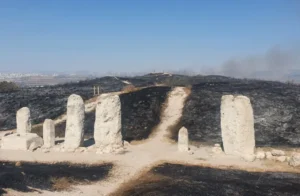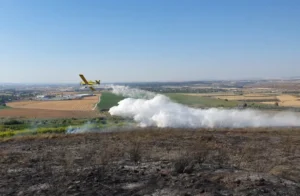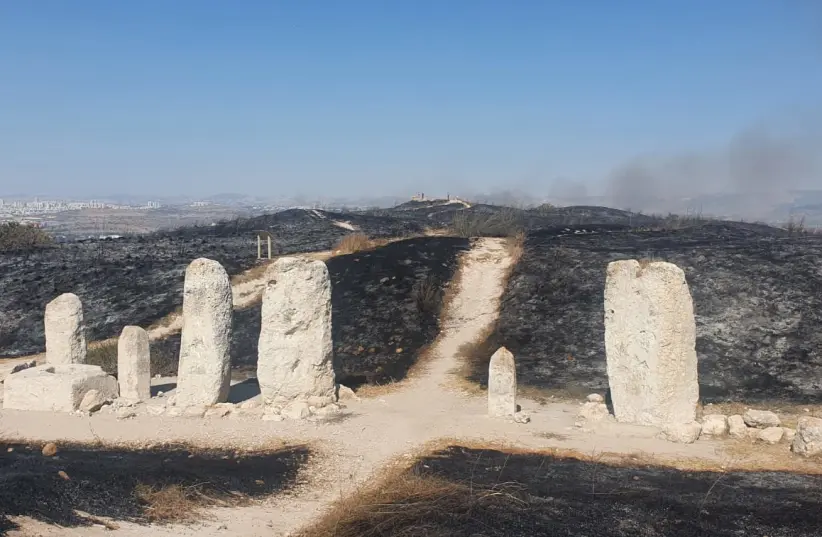‘One farmer caused the burning of an entire national park,’ fire spread quickly because of hot, dry and windy weather conditions.

Flames that spread from a pruning fire in the agricultural areas of Moshav Beit Uziel burned large areas of the Tel Gezer National Park on Monday.
According to initial assessments on Tuesday morning, no irreversible damage was done to the antiquities at the site, said Israel Nature and Parks Authority (INPA) Sharon Regional Director Roee Shtrauss.
“This morning we came with our restoration and conservation team to assess the damage and though we see that there has been damage done, until now we have not seen any irreversible damage,” Shtrauss said. “We will need to restore and clean the antiquities which have been burnt, but we need to do a more thorough study of the situation in order to better determine what needs to be done.”
“We will need to restore and clean the antiquities which have been burnt, but we need to do a more thorough study of the situation in order to better determine what needs to be done.”
Roee Shtrauss
He said 20 firefighters, including four planes and two helicopters, battled and extinguished the flames. Some 1,100 scouts camping in the nearby area were also evacuated according to Ynet. No injuries were reported.
Shtrauss said no damage was done to the ancient Canaanite water work system of Tel Gezer – the largest Canaanite water system ever discovered – which was only opened to the public in November 2021.

The history of Gezer
Gezer was a prominent fortified Canaanite city-state in the Middle Bronze Age. The archaeological tel covers an area of about 13 hectares (32 acres), and includes 26 settlement layers dating from the Chalcolithic period to the Early Roman period, from 3500 BCE to 100 BCE.
The ancient city was strategically located to control the junction of the Roman coastal Via Maris, or “Sea Road,” with the road to Jerusalem, making it one of the most important biblical mounds in the Land of Israel. Antiquities at the site include a Canaanite gate flanked by a high guard tower, a possible Canaanite cultic center with an impressive row of monoliths surrounding a basin, 13 boundary stones, the remains of a temple, and an eastern gate known as Solomon’s Gate.
The king of Gezer is mentioned in the Bible in Joshua 10:33 in the story of the Israelite conquest of Canaan. Gezer is also referenced in 1 Kings 9:15-17 as the city sacked by the Egyptian pharaoh who then gave the destroyed city to King Solomon as a dowry for his daughter whom Solomon married. According to the Bible, Solomon then rebuilt Gezer and made it into one of his great fortified cities along with Jerusalem, Megiddo and Hazor.
Yesterday’s fire spread quickly because of the windy, hot and dry conditions, noted Shtrauss.
“We will make a damage report, and with our experts who are assessing the situation, we will work on restoring the site and do everything possible so that it will be ready to reopen by next spring,” he said.
INPA Director-General Raya Soraki said in a statement that a government decision to rehabilitate Tel Gezer will be needed to allow the conservation and restoration work to be carried out and improve public access to the site before spring.
She noted that fire emphasized the need for a better accessibility to the site, as fire and rescue forces had difficulties reaching the area.
“I’m sorry the summer opened with a fire, in this case [due to] pruning and debris. A farmer caused the burning of an entire national park,” she said. “In light of the climate crisis, we are expecting a rise in temperature that could cause fires, so I call on the traveling public to take responsibility for avoiding lighting fires in open areas and nature reserves except in places approved for this.”
In the winter and spring season, which are the peak periods, about 50,000 people visit the Tel Gezer National Park, according to the INPA.

